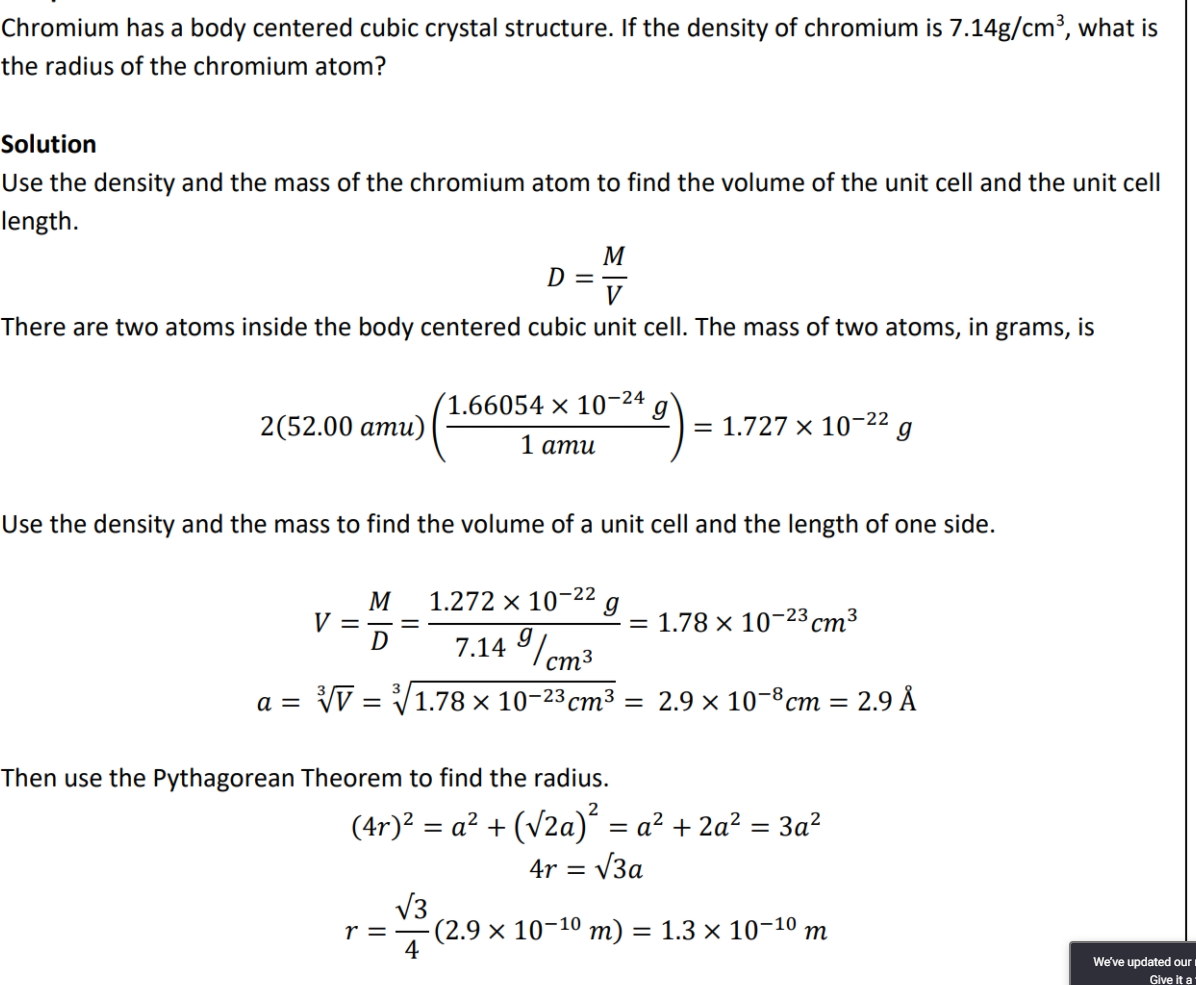hromium has a body centered cubic crystal structure. If the density of chromium is 7.14g/cm³, what is he radius of the chromium atom? olution se the density and the mass of the chromium atom to find the volume of the unit cell and the unit cell ength. M D = V here are two atoms inside the body centered cubic unit cell. The mass of two atoms, in grams, is -24 g = 1.727 × 10-22 g (1.66054 × 10* 2(52.00 ати) 1 ати
hromium has a body centered cubic crystal structure. If the density of chromium is 7.14g/cm³, what is he radius of the chromium atom? olution se the density and the mass of the chromium atom to find the volume of the unit cell and the unit cell ength. M D = V here are two atoms inside the body centered cubic unit cell. The mass of two atoms, in grams, is -24 g = 1.727 × 10-22 g (1.66054 × 10* 2(52.00 ати) 1 ати
Chemistry: Principles and Practice
3rd Edition
ISBN:9780534420123
Author:Daniel L. Reger, Scott R. Goode, David W. Ball, Edward Mercer
Publisher:Daniel L. Reger, Scott R. Goode, David W. Ball, Edward Mercer
Chapter11: Liquids And Solids
Section: Chapter Questions
Problem 11.78QE
Related questions
Question
I am very confused as to where you got the 1.272 x 10-22 from

Transcribed Image Text:Chromium has a body centered cubic crystal structure. If the density of chromium is 7.14g/cm³, what is
the radius of the chromium atom?
Solution
Use the density and the mass of the chromium atom to find the volume of the unit cell and the unit cell
length.
M
D =
V
There are two atoms inside the body centered cubic unit cell. The mass of two atoms, in grams, is
1.66054 × 10-24
2(52.00 ати)
= 1.727 × 10-22 a
1 ати
Use the density and the mass to find the volume of a unit cell and the length of one side.
1.272 × 10–22
M
V =
D
g
= 1.78 x 10-23
7.14
ст3
a = VV = V1.78 × 10-23cm³
= 2.9 x 10-8cm = 2.9 Å
%3D
Then use the Pythagorean Theorem to find the radius.
(4r)? = a² + (v2a)´ = a² + 2a² = 3a²
= V3a
4r =
V3
(2.9 × 10-10 m) = 1.3 × 10-10 m
4
r =
We've updated our
Give it a
Expert Solution
This question has been solved!
Explore an expertly crafted, step-by-step solution for a thorough understanding of key concepts.
This is a popular solution!
Trending now
This is a popular solution!
Step by step
Solved in 2 steps

Knowledge Booster
Learn more about
Need a deep-dive on the concept behind this application? Look no further. Learn more about this topic, chemistry and related others by exploring similar questions and additional content below.Recommended textbooks for you

Chemistry: Principles and Practice
Chemistry
ISBN:
9780534420123
Author:
Daniel L. Reger, Scott R. Goode, David W. Ball, Edward Mercer
Publisher:
Cengage Learning


Chemistry
Chemistry
ISBN:
9781305957404
Author:
Steven S. Zumdahl, Susan A. Zumdahl, Donald J. DeCoste
Publisher:
Cengage Learning

Chemistry: Principles and Practice
Chemistry
ISBN:
9780534420123
Author:
Daniel L. Reger, Scott R. Goode, David W. Ball, Edward Mercer
Publisher:
Cengage Learning


Chemistry
Chemistry
ISBN:
9781305957404
Author:
Steven S. Zumdahl, Susan A. Zumdahl, Donald J. DeCoste
Publisher:
Cengage Learning

Chemistry: An Atoms First Approach
Chemistry
ISBN:
9781305079243
Author:
Steven S. Zumdahl, Susan A. Zumdahl
Publisher:
Cengage Learning

Chemistry & Chemical Reactivity
Chemistry
ISBN:
9781337399074
Author:
John C. Kotz, Paul M. Treichel, John Townsend, David Treichel
Publisher:
Cengage Learning

Chemistry & Chemical Reactivity
Chemistry
ISBN:
9781133949640
Author:
John C. Kotz, Paul M. Treichel, John Townsend, David Treichel
Publisher:
Cengage Learning